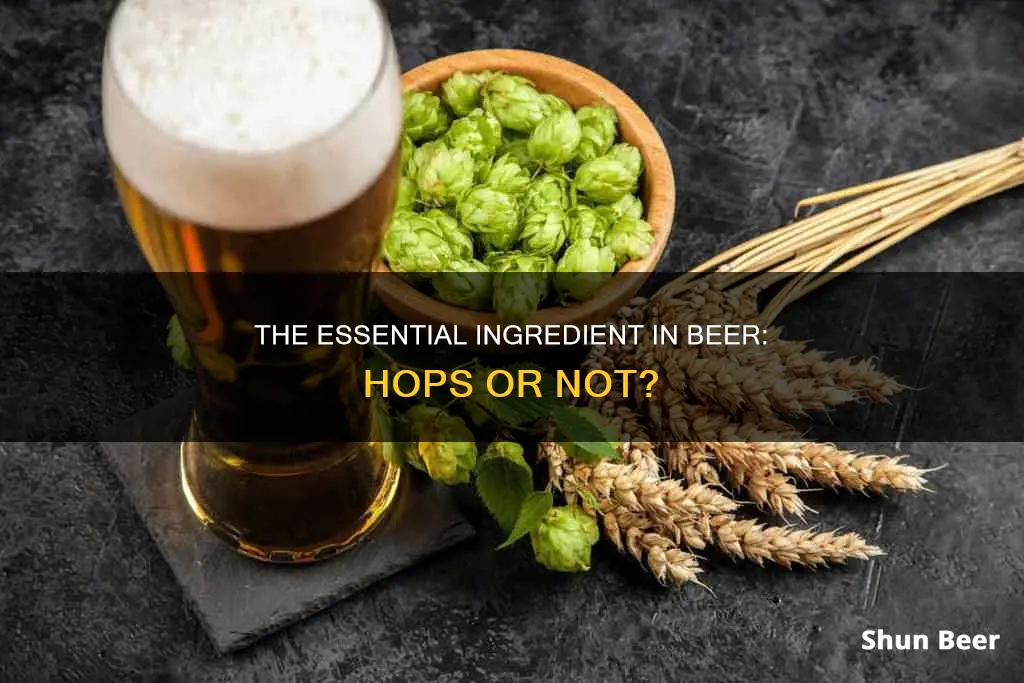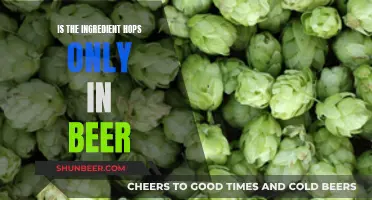
Hops are the flowers (also called seed cones or strobiles) of the female hop plant Humulus lupulus, a member of the Cannabaceae family of flowering plants. They are one of the four essential ingredients in beer, alongside barley, yeast, and water. Hops are primarily used as a bittering, flavouring, and stability agent in beer, adding floral, fruity, or citrus flavours and aromas. They also have antibacterial properties, which help to prevent spoilage and preserve the beer. The choice and timing of hops will vary depending on the style of beer being brewed and the desired flavour and aroma.
| Characteristics | Values |
|---|---|
| Main Ingredient | Hops are one of the four essential ingredients in beer, alongside barley, yeast, and water. |
| Source | Hops are the flowers (also called seed cones or strobiles) of the female hop plant Humulus lupulus, a member of the Cannabaceae family of flowering plants. |
| Flavour | Hops contribute a range of flavours to beer, including floral, citrus, herbal, and spicy notes. |
| Aroma | Hops contribute to the aroma of beer. The essential oils in hops give off a variety of fragrances, ranging from fruity to piney to earthy. |
| Preservation | Hops help to preserve beer by preventing the growth of bacteria, which can cause spoilage and spoil the flavour. |
| Foam Stabilisation | Hops help to stabilise the foam in beer, creating a more attractive appearance. |
| Bitterness | Hops are bitter. The longer they are boiled in the brewing process, the more bitter they become. |
What You'll Learn

Hops are added to beer at different stages of the brewing process to impart different flavours and aromas
Hops are typically added to the wort in three stages during the boil: bittering, flavour, and aroma. However, some beers may have only one addition, while others may have up to five or six. The type of hop used for each addition can vary, and it is not uncommon for the same variety to be used for multiple purposes.
Bittering hops are added early in the process to impart bitterness, as they release more alpha acids the longer they boil. These hops are boiled for around 60 minutes, though some recipes call for as little as 30 minutes. Without the bitterness from these hops, the beer would taste overly sweet.
Flavouring hops are added with between 15 and 30 minutes remaining in the boil. During this time frame, the crisp hoppy flavour is imparted without extracting much bitterness from the hops.
Aroma hops are added during the last 5 minutes of the boil or at flame-out to maximise the amount of aroma. The hop oils that contribute to aroma are extremely volatile and will be driven off in the steam of the boil if added too early.
Techniques such as dry hopping and wet hopping are also used to add aroma without the extra bitterness. Dry hopping involves adding hops to the fermenter, while wet hopping uses fresh, undried hops within 24 hours of being harvested.
Hops' Role in Brewing: Aromatic and Bitter Beer Balancing
You may want to see also

Hops are essential to the preservation of beer
Hops impart bitterness, flavour, and stability to beer. They help to balance the sweetness of the malt and contribute to the desired aroma. The choice and timing of hops addition depend on the style and flavour profile sought by the brewer. Hops can be added during the boil stage, which takes around an hour to extract the alpha acids. Adding hops later in the boil can enhance the aromatic profile, as a long boiling process destroys aromatic oils. Alternatively, hops can be dry-hopped, added directly to the fermenter, or fresh-hopped, where freshly picked hops are brought to the brewery without drying.
The type of hops used also varies based on the desired flavour and regional characteristics. For example, Tettnanger hops, sourced from Germany, are commonly used in lagers, imparting floral, earthy, and citrus notes. On the other hand, Columbus hops are popular in IPAs, providing bitterness along with earthy and spicy flavours.
The magic of hops lies in their ability to transform a simple brew into a complex and delightful beverage. They are the key to unlocking the desired bitterness, flavour, and aroma in beer, making them indispensable in the art of brewing. Without hops, beer would lack the depth of character and flavour that we know and love today.
Where to Find Tropical Hop Beer Near You
You may want to see also

Hops are the flowers of the female hops plant, aka Humulus lupulus
Hops, also known as the flowers of the female hops plant, or Humulus lupulus, are cone-shaped flowers that grow on a perennial, herbaceous, climbing plant. Native to West Asia, Europe, and North America, the hops plant can grow up to 10 metres (33 feet) tall and has a lifespan of up to 20 years. The species is dioecious, meaning it has separate male and female plants, and only the female plants are used for commercial hop production.
The female hops flowers are formed in clusters at the tips of the plant's stalks and branch tips, with each cluster containing 10 to 50 pairs of flowers enclosed by a green or yellow bract. The female flowers have long styles but no petals. In contrast, the male flowers form clusters of up to 100 flowers, each with five spreading sepals and short stamens, and dotted with yellow glands at their tips.
The hops plant is triggered to flower by the longer summer days, usually around July or August in the Northern Hemisphere. The flowers are wind-pollinated, with the male flowers lacking petals and the female flowers having petals that envelop the fruit. The female flower cones, also known as strobiles, are what we refer to as hops, and they are used primarily for flavouring and preserving beer.
Hops contain acids and oils that impart bitterness, flavour, and stability to beer. They are typically added during the boil stage of brewing, as it takes a long time (around an hour) to release the "alpha" acids that provide bitterness and balance the sweetness of the malt. The timing of when hops are added during the brewing process can vary depending on the desired flavour and aroma profile of the beer.
The Humulus lupulus species is widely cultivated for the brewing industry, and different varieties of hops are grown by farmers around the world, each imparting unique characteristics to the beer they are used in.
Wheat Beer and Hops: An Unlikely Friendship
You may want to see also

Hops are used to balance the sweetness of the malt
Hops are the flowers (also called seed cones or strobiles) of the hop plant Humulus lupulus, a member of the Cannabaceae family of flowering plants. They are used primarily as a bittering, flavouring, and stability agent in beer, to which, in addition to bitterness, they impart floral, fruity, or citrus flavours and aromas. Hops are added to balance the sweetness of the malt.
Malt, which is made from malted cereal grains, is the meat and potatoes of beer. It provides the sugars that are fermented by the yeast to create alcohol and CO2. It is also the primary source of beer colour and contributes significantly to flavour and mouthfeel. The most common malted grain is barley malt, but others include wheat, rye, and oats.
Hops, on the other hand, are the spice of beer. They provide bitterness to balance the sweetness of the malt, as well as flavours and aromas ranging from citrus and pine to earthy and spicy. Hops are the cone-like flower of a rapidly growing vine (a bine, actually) in the cannabis family. Waxy yellow lupulin glands hidden within the leaves of the flower contain the acids and essential oils that give hops their character. Bitterness comes from alpha acids that must be chemically altered through boiling in order to be utilized.
Hops are added to the wort in three stages during the boil: bittering, flavour, and aroma. All beers have at least one hop addition for bitterness, to balance the sweetness of the malt. However, the same hop variety might be used for bittering, flavouring, and aroma. Not all beers will have three additions; some may have only one, while others may have up to five or six additions.
The timing of the hop additions depends on their role in the beer. Bittering hops are added once the wort has been collected in the kettle (or after the malt extract has been added) and a rolling boil has been achieved. They are usually boiled for 60 minutes, although some recipes call for as little as 30 minutes. The main reason for this addition is that without the bitterness from the hops, the beer would taste syrupy-sweet.
Flavoring hops are generally added with between 15 and 30 minutes remaining in the boil. In this time frame, very little of the bitterness will be extracted from the hops, but that crisp hoppy flavor will be imparted. Again, these may be the same as the bittering or aroma hops; it is the time that they are boiled that makes the difference.
Aroma hops must not be boiled for long, as the essential oils in hops responsible for aroma are extremely volatile and will be driven off in the steam of the boil almost immediately. Therefore, aroma hops are typically added during the last 5 minutes of the boil or at flame out (when the kettle is removed from the heat). Adding hops at flame out will produce the maximum amount of aroma.
Scottish Beers: More Hops or Just a Myth?
You may want to see also

Hops are a natural preservative
Hops, the cone-shaped flowers of the female hops plant, are a natural preservative. They are one of the best natural preservatives available, and have been used largely as a preservative in beers. Hops have antibacterial effects, suppressing the growth of undesirable microorganisms. This is believed to be due to the antibiotic properties of the lupulin they contain, which includes lupulone and humulone.
Hops are added to the boil stage of brewing beer, as it takes a long time (around an hour) to unleash the "alpha" acids that bitter and balance the sweetness of the malt. The Belgians would dry their hops in the sun to remove the bittering and vegetative (chlorophyll) elements, and then add the bleached-out hops to the boil to preserve the beer without adding bitterness.
Hops are also used for their purported benefits, including balancing the sweetness of the malt with bitterness and a variety of flavours and aromas. They impart floral, fruity, or citrus flavours and aromas to beer.
Hops are a master climber and grower, growing up to seven metres long from the roots each year. They are also used in herbal teas and soft drinks, and the young shoots of the vine can be cooked and eaten.
Apple Cider Beer: Hops or No Hops?
You may want to see also
Frequently asked questions
No, not all beers have to be flavoured with hops. Before hops were used, beers were flavoured with a "gruit", a mixture of bitter herbs and flowers, including dandelion, burdock root, marigold, horehound, ground ivy, and heather.
Hops add a range of flavours to beer, including floral, citrus, herbal, and spicy notes. The specific flavour depends on the variety of hops used.
Hops have several functions in beer. They add bitterness, flavour, and aroma. They also act as a preservative, helping to prevent the growth of bacteria that can cause spoilage. Additionally, hops help to stabilise the foam in beer, creating a more attractive appearance.







